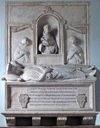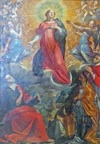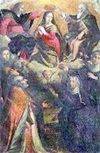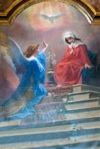

Maestro dell’ Assunta di Amelia (early 15th century)
This venerated altarpiece (early 15th century) of the Assumption of the Virgin is the autograph work of the Maestro dell’ Assunta di Amelia. It is usually under a cover in the Cappella dell' Assunta, in the left transept of the Duomo, but it is displayed to the right of the high altar in May and for a week in August.
Agostino di Duccio (died ca. 1481)
From Florence
-
✴the monument (1476) to Giovanni Geraldini, which has been clumsily recomposed in the Duomo; and
-
✴the monument (1477) to Matteo and Elisabetta Geraldini in San Francesco (illustrated here).
The marble slab from the funerary monument (ca. 1484) to Bishop Ruggero Mandosi, which is also in the Duomo, is less securely attributed to Agostino di Duccio.
Antoniazzo Romano (died after 1508)
This altarpiece (15th century) in the diocesan art collection in the Duomo, which is of unknown provenance, is a copy of the icon of the Madonna and Child in Santa Maria del Popolo, Rome. It is usually attributed to a follower of Antoniazzo Romano.
Pier Matteo d' Amelia (ca. 1445-1509)
Pier Matteo Lauro de' Manfredi, who came from a prominent family in Amelia, was among the most important Umbrian artists of the late 15th century. Two of his works in his native city are known:
-
✴A documented panel (ca. 1474) of St Antony Abbot Enthroned (a detail of which is illustrated here) came from the Observant Franciscans’ Convento di San Giovanni Battista and is now in the Pinacoteca Comunale.
-
✴A panel (ca. 1475) of the Annunciation was commissioned by the Clareni for the Convento della Santissima Annunziata and is now in the Isabella Stewart Gardner Museum, Boston. It was attributed to an unknown but important Master of the Gardner Annunciation in 1927, but given to Pier Matteo, with increasing reliability, from 1953.
Antonio da Sangallo il Giovane (1484-1546)
Antonio da Sangallo il Giovane was one of the leading architects in Rome, particularly after the election of Pope Paul III in 1534. He designed Palazzo Farrattini (ca. 1517) for Bishop Bartolomeo II Farrattini. He also produced designs (1517-8) for the restoration of the city’s defences.
Raffaello da Montelupo (1504-66)
From Montelupo Fiorentino: based in Rome and then in Orvieto
Raffaello da Montelupo survived the sack of Rome in 1527 and went on to work there under Michelangelo. He moved to Orvieto in 1552, and sent the last 15 years of his life as capomaestro at the Duomo there. He may well have designed the Cappella Farrattini of the Duomo of Amelia.
Giovanni Francesco Perini (died after 1574)
Perini, who was born in Amelia, was documented in Rome in 1523, when he belonged to the team at work in the Vatican Palace following the death of Raphael (in 1520). This damaged altarpiece (1538) of the Last Supper in the Duomo is the only one of his five documented works that survives.
Livio Agresti (1508–1580)
Livio Agresti signed two signed panels that survive in Amelia:
-
✴the Crucifixion with SS Firmina and Olympias (1557) in the Pinacoteca, which probably came from the Duomo (illustrated here) ; and
-
✴the Beheading of St John the Baptist (1571) in the ex-church of San Giovanni Decollato.
Frescoes (16th century) in Palazzo Boccarini and Palazzo Petrignani are attributed to him.
Litardo Piccioli (16th century)
Litardo Piccioli trained in Rome under Livio Agresti (above). No documented works are known. However, a number of works in Amelia and in the surrounding area are attributed to him. These include
-
✴a fresco (16th century) in Santa Monica, which depicts the Virgin protecting Amelia (illustrated here); and
-
✴two panels in the ex-church of San Giovanni Decollato, one of which is dated 1602.
Taddeo Zuccari (died 1566) and Federico Zuccari (died 1609)
From Urbino , based in Rome
Giovanni Antonio Dosio (1533-1611)
From San Gimìgnano, based in Rome in 1548-75
Ippolito Scalza (1532-1617)
From Orvieto
Antonio Circignani, il Pomarancio (1570-1630)
From Città della Pieve, based in Rome
Giuseppe Cesari, il Cavalier d’ Arpino (1568-1640)
From Arpino, based in Rome
The Cavalier d’ Arpino was probably the most important artist in Rome during first two decades of the 17th century, when he enjoyed the esteem and patronage of Pope Clement VIII. The fresco (17th century) in the ex-church of Sant’ Angelo that were attributed him have been destroyed.
[Temporary link to Giuseppe Cesari, il Cavalier d’ Arpino]
Bartolomeo Barbiani (died 1645)
An altarpiece (1642) of the Coronation of the Virgin with saints (illustrated here) in Santa Monica is signed by Bartolomeo Barbiani and dated by inscription. A panel (17th century) of the Visitation from San Francesco, which is now in the diocesan art collection in the Duomo, is attributed to him.
Andrea Polinori (1586-1648)
The altarpiece (1627) of the Assumption of the Virgin in San Magno is signed by Andrea Polinori and dated by inscription.
Marcantonio Grecchi (1573-1651)
An altarpiece (1639) in the Duomo, which depicts the Madonna and Child with saints, is signed by Marcantonio Grecchi and dated by inscription. A small panel in san magno is also attributed to him.
Giacinto Gimignani (1606-81)
Giacinto Gimignani had extensive links with Amelia, and four of his works are documented in the city:
-
✴a signed altarpiece (1675) depicting St Liborius, in the Duomo;
-
✴an altarpiece (17th century) of the Trinity with saints, in Sant’ Agostino; and
-
✴two works from Sant’ Angelo:
-
•a panel (17th century) of Christ on the Cross, which has been lost; and
-
•a panel (1677) of St Michael defeating the Devil, which is now in the Pinacoteca (illustrated here).
Francesco Appiani (1704-93)
Frescoes (1746-50) by Francesco Appiani in Sant’ Agostino depict:
-
✴the martyrdom of St Pancras, in the apse;
-
✴St Augustine in glory (signed and dated 1746), in the vault; and
-
✴two scenes in the tribune:
-
•the Nativity (illustrated here); and
-
•the Holy Family with St Anne (dated 1750).
Antonio Maria Garbi (1718-97)
From Tuoro sul Trasimeno, based in Perugia
A panel (18th century) that forms the backdrop to a crucifix above an altar in SS Annunziata is attributed to Antonio Maria Garbi.
[Temporary link to Antonio Maria Garbi]
Stefano Cansacchi (late 18th century)
The architect Conte Stefano Cansacchi, who belonged to a noble family of Amelia, attended the Accademia del Disegno, Perugia. A group of private citizens of Amelia commissioned him to design the new Teatro Sociale (1793).
Domenico Bruschi (1840-1910)
From Perugia





















